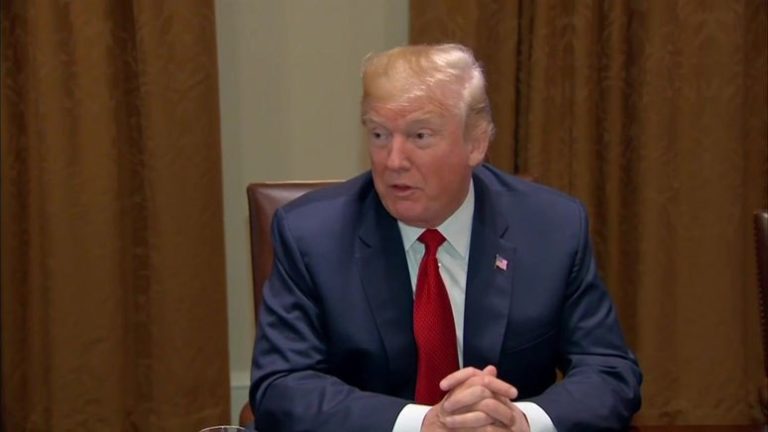In the wake of the Florida school shooting, President Donald Trump is reviving an old debate over whether violent video games can trigger violent behavior. There’s just one problem: Roughly two decades of research has repeatedly failed to uncover any such link.
Trump plans to meet Thursday with representatives from the video game industry. Trump’s recent public comments referencing the “vicious” level of game and movie violence in the context of school safety show that he is eager to explore the issue.
The Entertainment Software Association, the biggest video game trade group, said Monday that it will attend the meeting at the White House. A full list of attendees hasn’t been released. Here’s a look at the issues the meeting may address.
———
WHAT DOES RESEARCH SHOW?
Some studies have shown a connection between gaming and emotional arousal, although there’s no evidence that this heightened emotional state leads to physical violence.
In 2006, a small study by Indiana University found that teenagers who played violent?video games?showed higher levels of emotional arousal, but less activity in the parts of the brain associated with the ability to plan, control and direct thoughts and behavior.
The study assigned 44 adolescents to play either a violent or nonviolent but “equally fun and exciting”?video game?for half an hour. Researchers measured their brain function immediately after playing. The group that played the nonviolent game showed more activity in the prefrontal parts of the brain, which are involved in inhibition, concentration and self-control. They also showed less activity in the area involved in emotional arousal.
But if those changes have any impact on real-world behavior, researchers haven’t yet detected it.
Patrick Markey, a psychology professor at Villanova University who focuses on video games, found in his research that men who commit severe acts of violence actually play violent video games less than the average male. About 20 percent were interested in violent video games, compared with 70 percent of the general population, he explained in his 2017 book “Moral Combat: Why the War on Violent Video Games Is Wrong.”
Another study by Markey and his colleagues showed that violence tends to dip when a new violent movie or video game comes out, possibility because people are at home playing the game or in theaters watching the movie.
“Everything kind of suggests no link, or if anything, it goes in the opposite direction,” Markey said in an interview.
———
HAS THE WHITE HOUSE TAKEN THIS UP BEFORE?
In 2013, after the shooting at Sandy Hook elementary school in Newton, Connecticut, Vice President Joe Biden held three days of wide-ranging talks on gun violence prevention including a meeting with video game industry executives. At that meeting the Entertainment Software Association gave a statement similar to the one it issued on Monday.
“Like all Americans, we are deeply concerned about the level of gun violence in the United States,” the organization said Monday. “Video games are plainly not the issue: entertainment is distributed and consumed globally, but the U.S. has an exponentially higher level of gun violence than any other nation.”
After the 2013 meetings wrapped, the White House called on research on the effect of media and video games on gun violence but nothing substantial came out of that.
———
ARE VIRTUAL REALITY GAMES ANY DIFFERENT?
Because virtual-reality headsets and games are relatively new, there hasn’t been much research into the effects of immersion in violent virtual worlds. But experts say that such gaming hyperrealism is unlikely to make much of a difference.
“That’s an area that is ongoing and needs to be explored further, but games like ‘Call of Duty,’ are already pretty realistic,” said Benjamin Burroughs, a professor of emerging media at the University of Nevada in Las Vegas. “I have a hard time thinking there’s going to be a massive change in data due to the increased heightened sense of reality.”
———
WHAT ABOUT A RATINGS SYSTEM OR OTHER REGULATIONS?
Trump has suggested rating both games and movies for violence. Such ratings already exist.
Following an outcry over violent games such as 1992’s “Mortal Kombat,” the Entertainment Software Ratings Board was established in 1994 by the Entertainment Software Association to give each game a rating based on five-categories ranging from “E” for “Everyone” to “Adults Only” rating for those 18 and older.
The ratings suggest an age range and the type of content. The “mature” rating, for example, indicates the content is “generally suitable for ages 17 and up” and that the game “may contain intense violence, blood and gore, sexual content and/or strong language.”
In 2011 , the Supreme Court rejected a California law banning the sale of violent video games to children. The decision claimed that video games, like other media, are protected by the First Amendment.
In the majority, Justice Antonin Scalia wrote that the government can’t regulate depictions of violence, which he said were age-old, anyway: “Grimm’s Fairy Tales, for example, are grim indeed.”
(AP)












One Response
Degenerate president golfer is one of the most ignorant people ever to occupy the white house, and also could just be deflecting since he’s in the pocket of the nra.